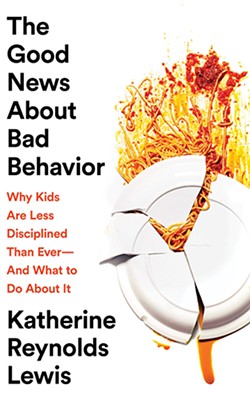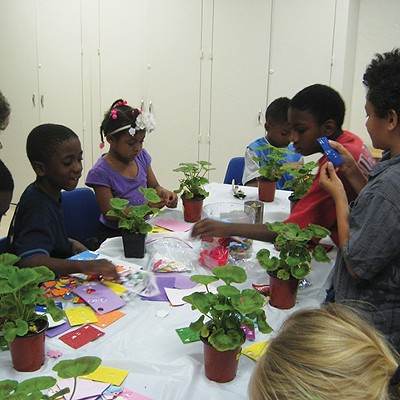Do timeouts work in your household? Do they extinguish your kids’ bad behavior? Do you find detentions and other punishments used at school pretty effective too? Great! You’ll have no use for “The Good News About Bad Behavior.” If there are one or two readers out there, however, who suspect that there’s a better way to raise calm, resilient, happy kids, here’s a hopeful alternative. Good News’ thesis is that it makes no sense to punish children for ‘bad behavior’-- and it doesn’t work. When they act out, it’s because they have a problem they don’t know how to solve. They just need a hand.
Lewis cites a recent study that demonstrates kids today can sit still for a quarter of the time their peers could in 1948. We have a crisis of self-regulation. Not only that, but one in two kids will have a mood disorder or substance abuse problem by the time they’re 18, and the rate of teen suicide has skyrocketed. Whether or not you’ve noticed a difference in children in the last few decades, as one of Lewis’ sources says, “you can’t argue with dead bodies.”
What we’re doing wrong
To egregiously over-generalize, when children are punished in a harsh way, they enter into “fight or flight” mode -- they can’t access the executive functioning part of their brain, so they can’t reason or learn from the experience. Even humane, enlightened punishments and rewards such as timeouts and sticker charts are ineffective because they offer only external accountability and actually undermine self-discipline. Kids don’t learn the benefit of, say, putting the milk back in the fridge when they’re done because we pick up after them and they don’t experience the direct consequences. There’s no motivation to discipline themselves. Lewis argues that we need to put more in kids’ “sphere of influence.” She argues that the problem is that kids are “unemployed.”
The apprenticeship model
The good news is the solution. Lewis calls this “the apprenticeship model.” It is a method of helping kids with “bad behavior” by helping them learn how to solve their problems, instead of punishing them for not knowing how. In her conception, kids are not little calculating criminals, but novices. And in order to get from novice to expert, they need not only education but on-the-job training -- a chance to learn from a trustworthy mentor how to get their needs met and deal with their feelings. Lewis recommends a three-pronged approach: connection, communication and capability, in that order.
Connection
We must first connect with our kids. When they inevitably experience stress, they are in fight or flight mode, and they need us to help get them to problem-solving mode. Bonding with parents helps a child self-regulate. As a parent and highly sensitive person myself, I have to comment that this is much easier said than done.
Personally, I was a little disappointed with the lack of consideration of parents’ stress levels in the book. Yes, of course our children need us to be calm and loving when they are screaming and kicking and throwing things, but until we have completed our zen master training, how do we keep our own very human emotional reactions (frustration, impatience, resentment) to our children’s outbursts in check?
In my experience (as a parent and a therapist), understanding kids’ behavior on a cognitive level isn’t enough. And faking it by holding ourselves to unreasonable standards-- swallowing our own feelings-- is not going to work. Strategies such as deep breathing, leaving the room for a moment to compose ourselves and religiously building stress relieving activities into our daily routines are vital. Reynolds briefly mentions walking out of the room and mumbling to yourself when you’re frustrated -- we need more tools like that. Let’s give ourselves the best hope we can of this connection succeeding.
Communication
We need more effective communication with our kids. When they’re having a meltdown, Lewis points to the use of touch and empathy as useful techniques and reminds us to resist the urge to solve the child’s problem.
“Our role as parents,” Reynolds writes, “isn’t to preside over an always peaceful household; it’s to see disruptions as a chance to better understand our children and help them grow.”
The most effective communication is observing and commenting on children’s specific interests, effort and choices- as opposed the empty praise (“good job!”) we Gen X’ers and millennials are known for receiving. Verbally noticing your child’s progress, rather than results, helps build their self-regulation skills. We need to communicate confidence, too, in our kids’ capability to navigate their own lives. “That sounds like a toughie with your friend! Will you let me know how it goes tomorrow on the playground?”
Capability
All right parents, this is the fun part, and it’s nothing new: chores. To increase their confidence, Lewis argues, we need to expand our kids’ sphere of influence. A recent study from California State University in Los Angeles of young adults correlated a sense of competence with a history of helping out with “family jobs.” Other research shows that that kids get the most out of jobs which they get to choose and the choice of how and when to perform them. Lewis recommends asking your child what they would like to learn to do themselves. Ask what they know already and build on that. Look for the type of tasks they gravitate towards already (sorting? stacking? planning?) and invite them to learn more. Give them dominion over some corner of the house, whether their bedroom or a playroom, and let them lose their favorite toys if it becomes a total mess.
There’s more to this approach of course, but if we keep in mind Lewis’ advice, we’ll be headed in the right direction. “Kids usually act up because they’re feeling useless – not able to contribute to the family or classroom – or because they lack emotional awareness and skills. In your home, look for opportunities to work on these skills, whether managing anger or navigating social situations.”
Ann Farrar is a health coach and psychotherapist in New York, NY. Lewis, Katherine Reynolds. The Good News About Bad Behavior. New York: Public Affairs, 2018.
The Good News About Bad Behavior
[
{
"name": "Air - MedRect Combo - Inline Content 1",
"component": "11490391",
"insertPoint": "3",
"requiredCountToDisplay": "1",
"parentWrapperClass": "fdn-ads-inline-content-block"
},{
"name": "Air - MedRect Combo - Inline Content 2",
"component": "11490392",
"insertPoint": "7",
"requiredCountToDisplay": "5",
"parentWrapperClass": "fdn-ads-inline-content-block"
},{
"name": "Air - MedRect Combo - Inline Content 3",
"component": "11490393",
"insertPoint": "12",
"requiredCountToDisplay": "9",
"parentWrapperClass": "fdn-ads-inline-content-block"
}
]
Illinois Times has provided readers with independent journalism for almost 50 years, from news and politics to arts and culture.
Your support will help cover the costs of editorial content published each week. Without local news organizations, we would be less informed about the issues that affect our community..
Got something to say?
Send a letter to the editor and we'll publish your feedback in print!




















